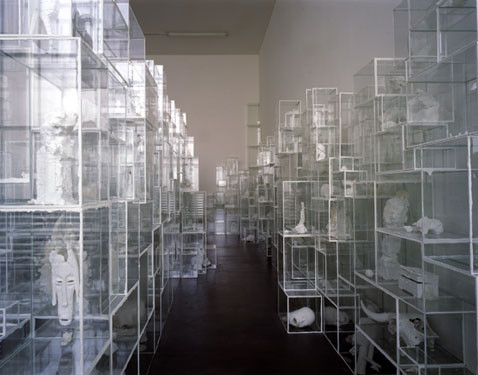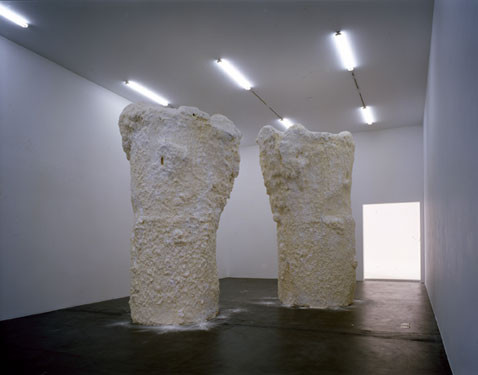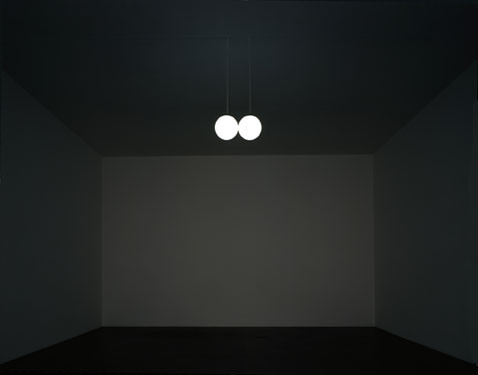Terence Koh
29 Aug - 29 Oct 2006

Terence Koh, Untitled, 2006
1184 glass cases with objects of various media including porcelain, wood, metal, bones, skulls, plastic,
bronze, plaster, paint
dimensions variable
Courtesy Peres Projects, Los Angeles Berlin
© A.Burger, Zürich / Kunsthalle Zürich
1184 glass cases with objects of various media including porcelain, wood, metal, bones, skulls, plastic,
bronze, plaster, paint
dimensions variable
Courtesy Peres Projects, Los Angeles Berlin
© A.Burger, Zürich / Kunsthalle Zürich

Terence Koh, Untitled, 2006
styrofoam, fiberglass, chocolate, paint
each 374 x 200 x 180 cm
Courtesy Peres Projects, Los Angeles Berlin
© A.Burger, Zürich / Kunsthalle Zürich
styrofoam, fiberglass, chocolate, paint
each 374 x 200 x 180 cm
Courtesy Peres Projects, Los Angeles Berlin
© A.Burger, Zürich / Kunsthalle Zürich

Terence Koh, Untitled, 2006
tapioca flour, wood, birdshit
dimensions variable
Courtesy Peres Projects, Los Angeles Berlin
© A.Burger, Zürich / Kunsthalle Zürich
tapioca flour, wood, birdshit
dimensions variable
Courtesy Peres Projects, Los Angeles Berlin
© A.Burger, Zürich / Kunsthalle Zürich

Terence Koh
Gone, Yet Still (Power, Power), 2006
2 glass orbs, 25-40 watt lightbulbs, wire
each 150 x 35 x 35 cm
Courtesy Peres Projects, Los Angeles Berlin
© A.Burger, Zürich / Kunsthalle Zürich
Gone, Yet Still (Power, Power), 2006
2 glass orbs, 25-40 watt lightbulbs, wire
each 150 x 35 x 35 cm
Courtesy Peres Projects, Los Angeles Berlin
© A.Burger, Zürich / Kunsthalle Zürich
TERENCE KOH
26 AUGUST – 29 OCTOBER 2006
Born 1977 in Bejing, Terence Koh who grew up in Canada, employs a wide variety of materials in his works - simultaneously: a crystal chandelier, lollipops, vegetables, hair of every conceivable origin, perfectly intact and deliberately destroyed glass, gold, extremely valuable china, the plastic of consumer items and kitsch, a hawser found after midnight, urine, blood, toys and much more.
Terence Koh, who is now mainly based in New York, but occasionally lives and works in Berlin, creates with his installations, objects, murals, but also in his performances, suggestive spaces in which recollection and fantasy are mixed with art history and sub-cultural extreme cultures (predominantly of the sexual, polymorph perverted type), in which contemporary trivial culture is united with fetish cultures and a use of rituals and practices that is historically and geographically taken from all cult cultures to create a cosmos that is both disrespectful and imbued with new mythology.
Koh generates aspects of seduction and irritation – a kind of dark Romanticism hovers over all his works. His “contaminations” of cultural practice are achieved using the principle of purity underlying modern aesthetics: either completely in white, black or gold with a superficial artistic surface vocabulary that derives from Minimalism and classic abstraction – but it is in the details that observers experience the contradictory aspects of his creations.
For Kunsthalle Zürich the artist re-worked a sequence of room-filling installations, which encompass emptiness and fullness, classic and kitsch, joy and pain, the celebration of conservation and destruction, Minimalism and opulence. The topic of duality and the confrontation of identities and opposite pairs are manifest in all the rooms of the exhibition; the visitor experiences this variously as being submerged in transparency, the danger of losing one's orientation as well as the fascination of white.
A doubled self-portrait in the form of a hanging head receives visitors and leads to two gigantic sculpture monsters, which rely on their magnificent yet frightening impact and make borrowings from the mythical figures of the Swiss mountain world (sweetened by a coating of Swiss chocolate).
Visitors then continue through the ephemeral atmosphere of the large, empty exhibition room, whose floor is completely covered with white powder. It is the temporary habitat for two birds – also white – which hang symbolically between salvation myth, peace kitsch and subjective pet fetishism – and which will, naturally, contaminate the purity of the white room with the evidence of their passing existence namely, feathers, excrement and waste. Visitors step out of this emptiness into a baroque-like presentation of 1,200 variously shaped display cases. The latter are filled to overflowing with trinkets and precious jewels and represent a boudoir of Koh's obsessions almost too bountiful to be taken in. Once again the artist plays with duality by combining objects found in flea markets and expensive china stores with art objects, kitsch, Gothic cult items, marketing paraphernalia from the movie and music industries, ritual items and tourist trinkets and repeats all of these objects in his own version. In such repetitions he cites the entire history of miracle cabinets, art display cases, devotionals, and Minimal art installations – a subjective cosmos filled with found and
vicarious rubbish and glitter, which presents man's ephemeral existence to us as both sickly sweet and shocking.
From this ambivalent boudoir he leads us into an elegant minimal lamp installation, which also evokes a large repertoire of associations: Two spherical lamps are so installed that they touch each other “kissing”. They call to mind Felix Gonzalez-Torres' famous dual clock, the tragically beautiful duo fated to burn out over time – jointly yet in isolation; and they also recall Jorge Pardo's lamp installations that corrupt beautiful design by stirring downright emotive associations of “balls” - the male sexual organs.
Thanks to the artist's subjective narration, a whole sea of cultural explanations, meanings, manifestations, obscurities and myths is cleverly exposed to new interpretations.
Terence Koh's topics are the major themes of mankind: life and death, youthfulness and decay, beauty and illness, cultural identity and individual personality, sexuality, civilization and that other which is controlled by the conventions of our culture but also the concepts, which run through the various cultures of Freudian eros and thanatos. In recent years topics of both cultural and individual identity have increasingly been ignored by critical discourse, that also includes questions about who looks how and at what, what identity meets the cultural consensus and what happens when this becomes relevant in intercultural terms. In his essay on Terence Koh, Bruce Benderson writes that the insistence on remaining within the matrix [of an] exclusively male form of desire and sexuality, enabled him to develop a sense of existence that penetrates everything I make or create. Terence Koh's cultural borrowings, reformations of cultural practice and his cross-fades of aesthetic conventions are infused with such an existential feeling. They enable “another”, not primarily autobiographical but a subjectively chosen identity and a view of free space shaped by a particular lifestyle. They are “queer” spaces of self-definition and discourse with heterogeneous spaces, which the globalised reality of today can have.
26 AUGUST – 29 OCTOBER 2006
Born 1977 in Bejing, Terence Koh who grew up in Canada, employs a wide variety of materials in his works - simultaneously: a crystal chandelier, lollipops, vegetables, hair of every conceivable origin, perfectly intact and deliberately destroyed glass, gold, extremely valuable china, the plastic of consumer items and kitsch, a hawser found after midnight, urine, blood, toys and much more.
Terence Koh, who is now mainly based in New York, but occasionally lives and works in Berlin, creates with his installations, objects, murals, but also in his performances, suggestive spaces in which recollection and fantasy are mixed with art history and sub-cultural extreme cultures (predominantly of the sexual, polymorph perverted type), in which contemporary trivial culture is united with fetish cultures and a use of rituals and practices that is historically and geographically taken from all cult cultures to create a cosmos that is both disrespectful and imbued with new mythology.
Koh generates aspects of seduction and irritation – a kind of dark Romanticism hovers over all his works. His “contaminations” of cultural practice are achieved using the principle of purity underlying modern aesthetics: either completely in white, black or gold with a superficial artistic surface vocabulary that derives from Minimalism and classic abstraction – but it is in the details that observers experience the contradictory aspects of his creations.
For Kunsthalle Zürich the artist re-worked a sequence of room-filling installations, which encompass emptiness and fullness, classic and kitsch, joy and pain, the celebration of conservation and destruction, Minimalism and opulence. The topic of duality and the confrontation of identities and opposite pairs are manifest in all the rooms of the exhibition; the visitor experiences this variously as being submerged in transparency, the danger of losing one's orientation as well as the fascination of white.
A doubled self-portrait in the form of a hanging head receives visitors and leads to two gigantic sculpture monsters, which rely on their magnificent yet frightening impact and make borrowings from the mythical figures of the Swiss mountain world (sweetened by a coating of Swiss chocolate).
Visitors then continue through the ephemeral atmosphere of the large, empty exhibition room, whose floor is completely covered with white powder. It is the temporary habitat for two birds – also white – which hang symbolically between salvation myth, peace kitsch and subjective pet fetishism – and which will, naturally, contaminate the purity of the white room with the evidence of their passing existence namely, feathers, excrement and waste. Visitors step out of this emptiness into a baroque-like presentation of 1,200 variously shaped display cases. The latter are filled to overflowing with trinkets and precious jewels and represent a boudoir of Koh's obsessions almost too bountiful to be taken in. Once again the artist plays with duality by combining objects found in flea markets and expensive china stores with art objects, kitsch, Gothic cult items, marketing paraphernalia from the movie and music industries, ritual items and tourist trinkets and repeats all of these objects in his own version. In such repetitions he cites the entire history of miracle cabinets, art display cases, devotionals, and Minimal art installations – a subjective cosmos filled with found and
vicarious rubbish and glitter, which presents man's ephemeral existence to us as both sickly sweet and shocking.
From this ambivalent boudoir he leads us into an elegant minimal lamp installation, which also evokes a large repertoire of associations: Two spherical lamps are so installed that they touch each other “kissing”. They call to mind Felix Gonzalez-Torres' famous dual clock, the tragically beautiful duo fated to burn out over time – jointly yet in isolation; and they also recall Jorge Pardo's lamp installations that corrupt beautiful design by stirring downright emotive associations of “balls” - the male sexual organs.
Thanks to the artist's subjective narration, a whole sea of cultural explanations, meanings, manifestations, obscurities and myths is cleverly exposed to new interpretations.
Terence Koh's topics are the major themes of mankind: life and death, youthfulness and decay, beauty and illness, cultural identity and individual personality, sexuality, civilization and that other which is controlled by the conventions of our culture but also the concepts, which run through the various cultures of Freudian eros and thanatos. In recent years topics of both cultural and individual identity have increasingly been ignored by critical discourse, that also includes questions about who looks how and at what, what identity meets the cultural consensus and what happens when this becomes relevant in intercultural terms. In his essay on Terence Koh, Bruce Benderson writes that the insistence on remaining within the matrix [of an] exclusively male form of desire and sexuality, enabled him to develop a sense of existence that penetrates everything I make or create. Terence Koh's cultural borrowings, reformations of cultural practice and his cross-fades of aesthetic conventions are infused with such an existential feeling. They enable “another”, not primarily autobiographical but a subjectively chosen identity and a view of free space shaped by a particular lifestyle. They are “queer” spaces of self-definition and discourse with heterogeneous spaces, which the globalised reality of today can have.
